Physical layer in the OSI model plays the role of interacting with
actual hardware and signaling mechanism. Physical layer is the only
layer of OSI network model which actually deals with the physical
connectivity of two different stations. This layer defines the hardware
equipment, cabling, wiring, frequencies, pulses used to represent
binary signals etc.
Physical layer provides its services to Data-link layer. Data-link
layer hands over frames to physical layer. Physical layer converts them
to electrical pulses, which represent binary data.The binary data is
then sent over the wired or wireless media.
When data is sent over physical medium, it needs to be first
converted into electromagnetic signals. Data itself can be analog such
as human voice, or digital such as file on the disk.Both analog and
digital data can be represented in digital or analog signals.
When signals travel through the medium they tend to deteriorate. This may have many reasons as given:
The media over which the information between two computer systems is
sent, called transmission media. Transmission media comes in two forms.
The speed of transmission of information is said to be the channel
capacity. We count it as data rate in digital world. It depends on
numerous factors such as:
Multiplexing is a technique to mix and send multiple data streams
over a single medium. This technique requires system hardware called
multiplexer (MUX) for multiplexing the streams and sending them on a
medium, and de-multiplexer (DMUX) which takes information from the
medium and distributes to different destinations.
Switching is a mechanism by which data/information sent from source
towards destination which are not directly connected. Networks have
interconnecting devices, which receives data from directly connected
sources, stores data, analyze it and then forwards to the next
interconnecting device closest to the destination.
Digital Transmission
Data or information can be stored in two ways, analog and digital.
For a computer to use the data, it must be in discrete digital
form.Similar to data, signals can also be in analog and digital form. To
transmit data digitally, it needs to be first converted to digital
form.
Digital-to-Digital Conversion
This section explains how to convert digital data into digital
signals. It can be done in two ways, line coding and block coding. For
all communications, line coding is necessary whereas block coding is
optional.
Line Coding
The process for converting digital data into digital signal is said
to be Line Coding. Digital data is found in binary format.It is
represented (stored) internally as series of 1s and 0s.
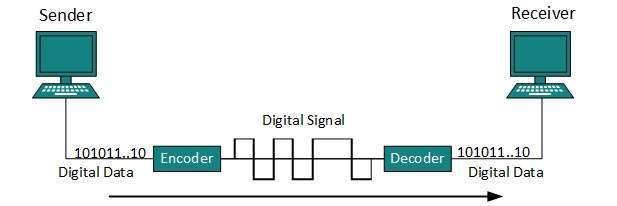
Digital signal is denoted by discreet signal, which represents
digital data.There are three types of line coding schemes available:

Uni-polar Encoding
Unipolar encoding schemes use single voltage level to represent data.
In this case, to represent binary 1, high voltage is transmitted and
to represent 0, no voltage is transmitted. It is also called
Unipolar-Non-return-to-zero, because there is no rest condition i.e. it
either represents 1 or 0.
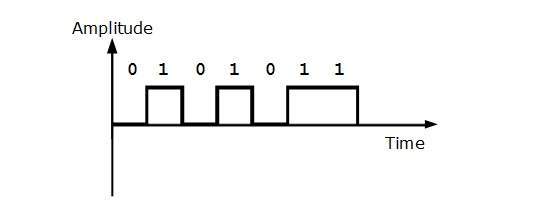
Polar Encoding
Polar encoding scheme uses multiple voltage levels to represent binary values. Polar encodings is available in four types:
Polar Non-Return to Zero (Polar NRZ)
It uses two different voltage levels to represent binary values.
Generally, positive voltage represents 1 and negative value represents
0. It is also NRZ because there is no rest condition.
NRZ scheme has two variants: NRZ-L and NRZ-I.
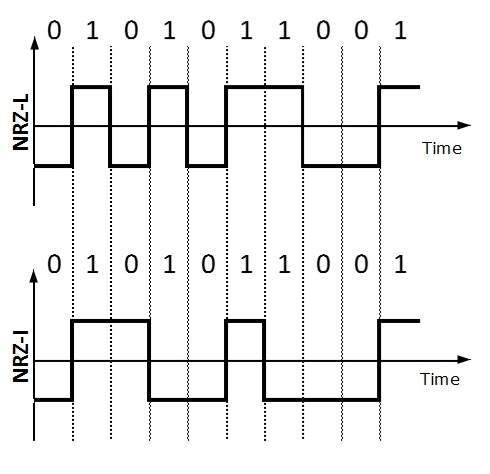
NRZ-L changes voltage level at when a different bit is encountered whereas NRZ-I changes voltage when a 1 is encountered.
Return to Zero (RZ)
Problem with NRZ is that the receiver cannot conclude when a bit
ended and when the next bit is started, in case when sender and
receiver’s clock are not synchronized.
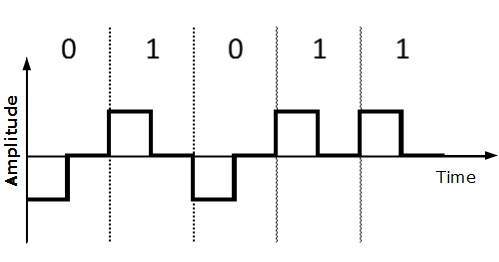
RZ uses three voltage levels, positive voltage to represent 1,
negative voltage to represent 0 and zero voltage for none. Signals
change during bits not between bits.
Manchester
This encoding scheme is a combination of RZ and NRZ-L. Bit time is
divided into two halves. It transits in the middle of the bit and
changes phase when a different bit is encountered.
Differential Manchester
This encoding scheme is a combination of RZ and NRZ-I. It also
transit at the middle of the bit but changes phase only when 1 is
encountered.
Bipolar Encoding
Bipolar encoding uses three voltage levels, positive, negative and
zero. Zero voltage represents binary 0 and bit 1 is represented by
altering positive and negative voltages.
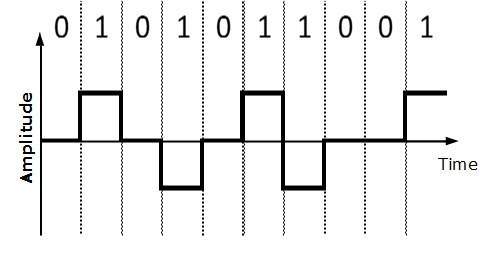
Block Coding
To ensure accuracy of the received data frame redundant bits are
used. For example, in even-parity, one parity bit is added to make the
count of 1s in the frame even. This way the original number of bits is
increased. It is called Block Coding.
Block coding is represented by slash notation, mB/nB.Means, m-bit
block is substituted with n-bit block where n > m. Block coding
involves three steps:
- Division,
- Substitution
- Combination.
After block coding is done, it is line coded for transmission.
Analog-to-Digital Conversion
Microphones create analog voice and camera creates analog videos,
which are treated is analog data. To transmit this analog data over
digital signals, we need analog to digital conversion.
Analog data is a continuous stream of data in the wave form whereas
digital data is discrete. To convert analog wave into digital data, we
use Pulse Code Modulation (PCM).
PCM is one of the most commonly used method to convert analog data into digital form. It involves three steps:
- Sampling
- Quantization
- Encoding.
Sampling

The analog signal is sampled every T interval. Most important factor
in sampling is the rate at which analog signal is sampled. According
to Nyquist Theorem, the sampling rate must be at least two times of the
highest frequency of the signal.
Quantization

Sampling yields discrete form of continuous analog signal. Every
discrete pattern shows the amplitude of the analog signal at that
instance. The quantization is done between the maximum amplitude value
and the minimum amplitude value. Quantization is approximation of the
instantaneous analog value.
Encoding

In encoding, each approximated value is then converted into binary format.
Transmission Modes
The transmission mode decides how data is transmitted between two
computers.The binary data in the form of 1s and 0s can be sent in two
different modes: Parallel and Serial.
Parallel Transmission

The binary bits are organized in-to groups of fixed length. Both
sender and receiver are connected in parallel with the equal number of
data lines. Both computers distinguish between high order and low order
data lines. The sender sends all the bits at once on all lines.Because
the data lines are equal to the number of bits in a group or data
frame, a complete group of bits (data frame) is sent in one go.
Advantage of Parallel transmission is high speed and disadvantage is the
cost of wires, as it is equal to the number of bits sent in parallel.
Serial Transmission
In serial transmission, bits are sent one after another in a queue
manner. Serial transmission requires only one communication channel.

Serial transmission can be either asynchronous or synchronous.
Asynchronous Serial Transmission
It is named so because there’is no importance of timing. Data-bits
have specific pattern and they help receiver recognize the start and end
data bits.For example, a 0 is prefixed on every data byte and one or
more 1s are added at the end.
Two continuous data-frames (bytes) may have a gap between them.
Synchronous Serial Transmission
Timing in synchronous transmission has importance as there is no
mechanism followed to recognize start and end data bits.There is no
pattern or prefix/suffix method. Data bits are sent in burst mode
without maintaining gap between bytes (8-bits). Single burst of data
bits may contain a number of bytes. Therefore, timing becomes very
important.
It is up to the receiver to recognize and separate bits into
bytes.The advantage of synchronous transmission is high speed, and it
has no overhead of extra header and footer bits as in asynchronous
transmission.
Analog Transmission
To send the digital data over an analog media, it needs to be
converted into analog signal.There can be two cases according to data
formatting.
Bandpass:The filters are used to filter and pass frequencies of interest. A bandpass is a band of frequencies which can pass the filter.
Low-pass: Low-pass is a filter that passes low frequencies signals.
When digital data is converted into a bandpass analog signal, it is
called digital-to-analog conversion. When low-pass analog signal is
converted into bandpass analog signal, it is called analog-to-analog
conversion.
Digital-to-Analog Conversion
When data from one computer is sent to another via some analog
carrier, it is first converted into analog signals. Analog signals are
modified to reflect digital data.
An analog signal is characterized by its amplitude, frequency, and
phase. There are three kinds of digital-to-analog conversions:
Amplitude Shift Keying
In this conversion technique, the amplitude of analog carrier signal is modified to reflect binary data.
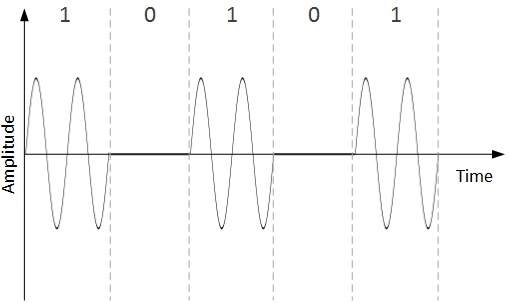
When binary data represents digit 1, the amplitude is held; otherwise
it is set to 0. Both frequency and phase remain same as in the
original carrier signal.
Frequency Shift Keying
In this conversion technique, the frequency of the analog carrier signal is modified to reflect binary data.
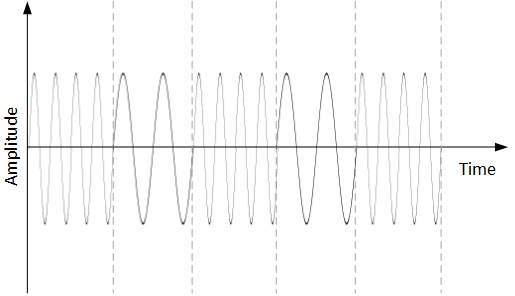
This technique uses two frequencies, f1 and f2. One of them, for
example f1, is chosen to represent binary digit 1 and the other one is
used to represent binary digit 0. Both amplitude and phase of the
carrier wave are kept intact.
Phase Shift Keying
In this conversion scheme, the phase of the original carrier signal is altered to reflect the binary data.
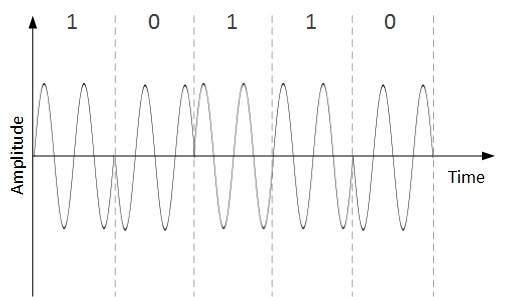
When a new binary symbol is encountered, the phase of the signal is
altered. Amplitude and frequency of the original carrier signal is kept
intact.
Quadrature Phase Shift Keying
QPSK alters the phase to reflect two binary digits at once. This is
done in two different phases. The main stream of binary data is divided
equally into two sub-streams. The serial data is converted in to
parallel in both sub-streams and then each stream is converted to
digital signal using NRZ technique. Later, both the digital signals are
merged together.
Analog-to-Analog Conversion
Analog signals are modified to represent analog data. This
conversion is also known as Analog Modulation. Analog modulation is
required when bandpass is used. Analog to analog conversion can be done
in three ways:

Amplitude Modulation
In this modulation, the amplitude of the carrier signal is modified to reflect the analog data.
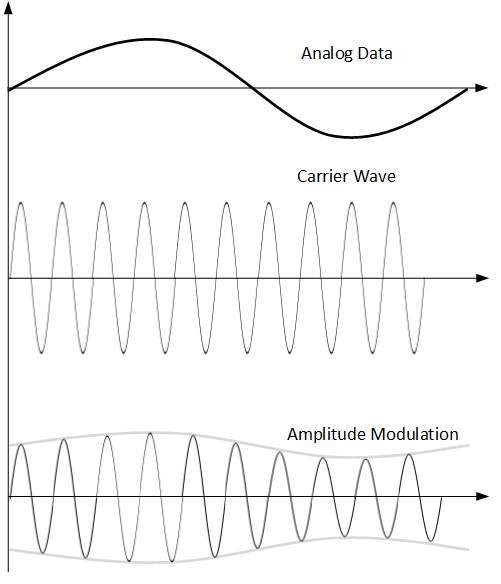
Amplitude modulation is implemented by means of a multiplier. The
amplitude of modulating signal (analog data) is multiplied by the
amplitude of carrier frequency, which then reflects analog data.
The frequency and phase of carrier signal remain unchanged.
Frequency Modulation
In this modulation technique, the frequency of the carrier signal is
modified to reflect the change in the voltage levels of the modulating
signal (analog data).
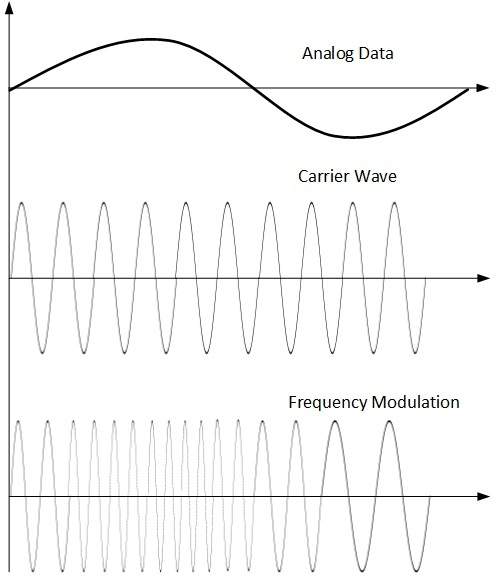
The amplitude and phase of the carrier signal are not altered.
Phase Modulation
In the modulation technique, the phase of carrier signal is modulated
in order to reflect the change in voltage (amplitude) of analog data
signal.
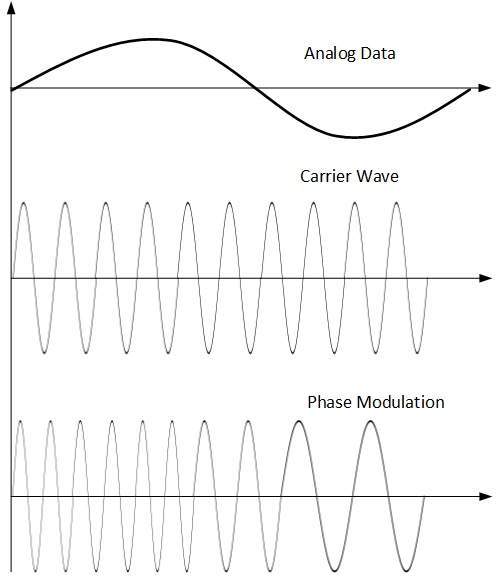
Phase modulation is practically similar to Frequency Modulation, but
in Phase modulation frequency of the carrier signal is not increased.
Frequency of carrier is signal is changed (made dense and sparse) to
reflect voltage change in the amplitude of modulating signal.
Transmission Media
The transmission media is nothing but the physical media over which communication takes place in computer networks.
Magnetic Media
One of the most convenient way to transfer data from one computer to
another, even before the birth of networking, was to save it on some
storage media and transfer physical from one station to another. Though
it may seem old-fashion way in today’s world of high speed internet,
but when the size of data is huge, the magnetic media comes into play.
For example, a bank has to handle and transfer huge data of its
customer, which stores a backup of it at some geographically far-away
place for security reasons and to keep it from uncertain calamities. If
the bank needs to store its huge backup data then its,transfer through
internet is not feasible.The WAN links may not support such high
speed.Even if they do; the cost too high to afford.
In these cases, data backup is stored onto magnetic tapes or magnetic discs, and then shifted physically at remote places.
Twisted Pair Cable
A twisted pair cable is made of two plastic insulated copper wires
twisted together to form a single media. Out of these two wires, only
one carries actual signal and another is used for ground reference. The
twists between wires are helpful in reducing noise (electro-magnetic
interference) and crosstalk.
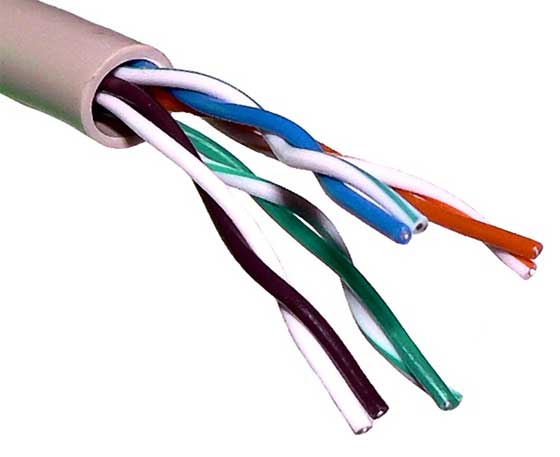
There are two types of twisted pair cables:
Shielded Twisted Pair (STP) Cable
Unshielded Twisted Pair (UTP) Cable
STP cables comes with twisted wire pair covered in metal foil. This makes it more indifferent to noise and crosstalk.
UTP has seven categories, each suitable for specific use. In
computer networks, Cat-5, Cat-5e, and Cat-6 cables are mostly used. UTP
cables are connected by RJ45 connectors.
Coaxial Cable
Coaxial cable has two wires of copper. The core wire lies in the
center and it is made of solid conductor.The core is enclosed in an
insulating sheath.The second wire is wrapped around over the sheath and
that too in turn encased by insulator sheath.This all is covered by
plastic cover.
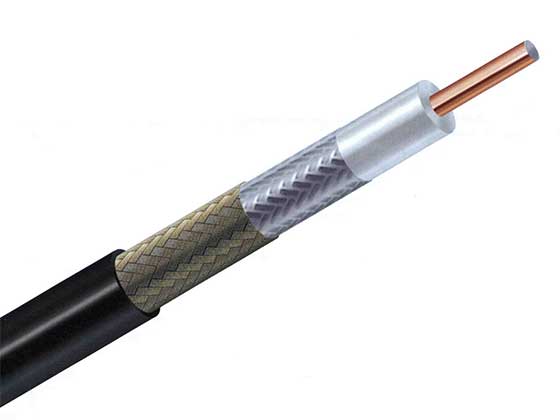
Because of its structure,the coax cable is capable of carrying high
frequency signals than that of twisted pair cable.The wrapped structure
provides it a good shield against noise and cross talk. Coaxial cables
provide high bandwidth rates of up to 450 mbps.
There are three categories of coax cables namely, RG-59 (Cable TV),
RG-58 (Thin Ethernet), and RG-11 (Thick Ethernet). RG stands for Radio
Government.
Cables are connected using BNC connector and BNC-T. BNC terminator is used to terminate the wire at the far ends.
Power Lines
Power Line communication (PLC) is Layer-1 (Physical Layer) technology
which uses power cables to transmit data signals.In PLC, modulated data
is sent over the cables. The receiver on the other end de-modulates
and interprets the data.
Because power lines are widely deployed, PLC can make all powered devices controlled and monitored. PLC works in half-duplex.
There are two types of PLC:
Narrow band PLC
Broad band PLC
Narrow band PLC provides lower data rates up to 100s of kbps, as they
work at lower frequencies (3-5000 kHz).They can be spread over several
kilometers.
Broadband PLC provides higher data rates up to 100s of Mbps and works
at higher frequencies (1.8 – 250 MHz).They cannot be as much extended
as Narrowband PLC.
Fiber Optics
Fiber Optic works on the properties of light. When light ray hits at
critical angle it tends to refracts at 90 degree. This property has
been used in fiber optic. The core of fiber optic cable is made of high
quality glass or plastic. From one end of it light is emitted, it
travels through it and at the other end light detector detects light
stream and converts it to electric data.
Fiber Optic provides the highest mode of speed. It comes in two
modes, one is single mode fiber and second is multimode fiber. Single
mode fiber can carry a single ray of light whereas multimode is capable
of carrying multiple beams of light.
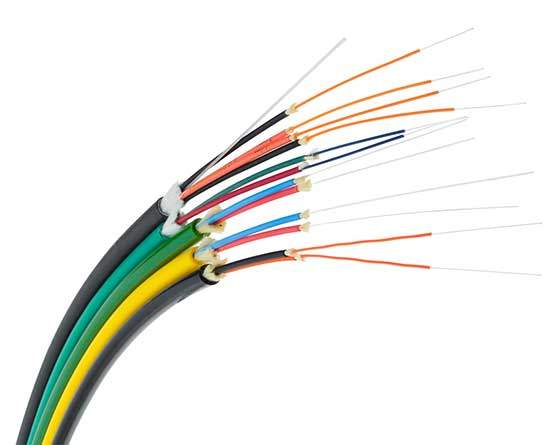
Fiber Optic also comes in unidirectional and bidirectional
capabilities. To connect and access fiber optic special type of
connectors are used. These can be Subscriber Channel (SC), Straight Tip
(ST), or MT-RJ.
Wireless Transmission
Wireless transmission is a form of unguided media. Wireless
communication involves no physical link established between two or more
devices, communicating wirelessly. Wireless signals are spread over in
the air and are received and interpreted by appropriate antennas.
When an antenna is attached to electrical circuit of a computer or
wireless device, it converts the digital data into wireless signals and
spread all over within its frequency range. The receptor on the other
end receives these signals and converts them back to digital data.
A little part of electromagnetic spectrum can be used for wireless transmission.

Radio Transmission
Radio frequency is easier to generate and because of its large
wavelength it can penetrate through walls and structures alike.Radio
waves can have wavelength from 1 mm – 100,000 km and have frequency
ranging from 3 Hz (Extremely Low Frequency) to 300 GHz (Extremely High
Frequency). Radio frequencies are sub-divided into six bands.
Radio waves at lower frequencies can travel through walls whereas
higher RF can travel in straight line and bounce back.The power of low
frequency waves decreases sharply as they cover long distance. High
frequency radio waves have more power.
Lower frequencies such as VLF, LF, MF bands can travel on the ground up to 1000 kilometers, over the earth’s surface.
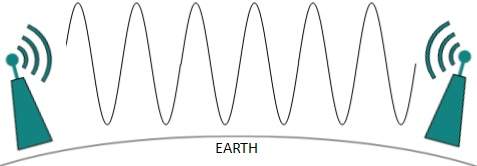
Radio waves of high frequencies are prone to be absorbed by rain and
other obstacles. They use Ionosphere of earth atmosphere. High
frequency radio waves such as HF and VHF bands are spread upwards. When
they reach Ionosphere, they are refracted back to the earth.
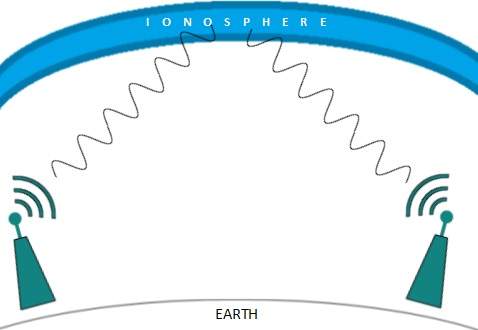
Microwave Transmission
Electromagnetic waves above 100 MHz tend to travel in a straight line
and signals over them can be sent by beaming those waves towards one
particular station. Because Microwaves travels in straight lines, both
sender and receiver must be aligned to be strictly in line-of-sight.
Microwaves can have wavelength ranging from 1 mm – 1 meter and frequency ranging from 300 MHz to 300 GHz.

Microwave antennas concentrate the waves making a beam of it. As
shown in picture above, multiple antennas can be aligned to reach
farther. Microwaves have higher frequencies and do not penetrate wall
like obstacles.
Microwave transmission depends highly upon the weather conditions and the frequency it is using.
Infrared Transmission
Infrared wave lies in between visible light spectrum and microwaves.
It has wavelength of 700-nm to 1-mm and frequency ranges from 300-GHz
to 430-THz.
Infrared wave is used for very short range communication purposes
such as television and it’s remote. Infrared travels in a straight line
hence it is directional by nature. Because of high frequency range,
Infrared cannot cross wall-like obstacles.
Light Transmission
Highest most electromagnetic spectrum which can be used for data
transmission is light or optical signaling. This is achieved by means
of LASER.
Because of frequency light uses, it tends to travel strictly in
straight line.Hence the sender and receiver must be in the
line-of-sight. Because laser transmission is unidirectional, at both
ends of communication the laser and the photo-detector needs to be
installed. Laser beam is generally 1mm wide hence it is a work of
precision to align two far receptors each pointing to lasers source.
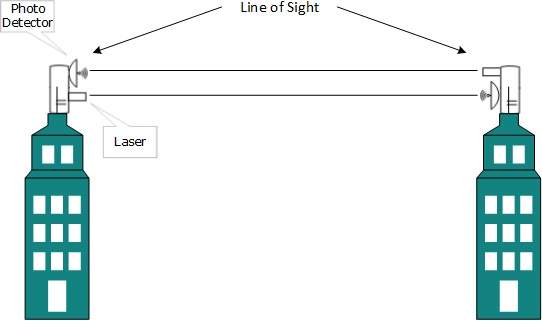
Laser works as Tx (transmitter) and photo-detectors works as Rx (receiver).
Lasers cannot penetrate obstacles such as walls, rain, and thick fog.
Additionally, laser beam is distorted by wind, atmosphere temperature,
or variation in temperature in the path.
Laser is safe for data transmission as it is very difficult to tap
1mm wide laser without interrupting the communication channel.
Multiplexing
Multiplexing is a technique by which different analog and digital
streams of transmission can be simultaneously processed over a shared
link. Multiplexing divides the high capacity medium into low capacity
logical medium which is then shared by different streams.
Communication is possible over the air (radio frequency), using a
physical media (cable), and light (optical fiber). All mediums are
capable of multiplexing.
When multiple senders try to send over a single medium, a device
called Multiplexer divides the physical channel and allocates one to
each. On the other end of communication, a De-multiplexer receives data
from a single medium, identifies each, and sends to different
receivers.
Frequency Division Multiplexing
When the carrier is frequency, FDM is used. FDM is an analog
technology. FDM divides the spectrum or carrier bandwidth in logical
channels and allocates one user to each channel. Each user can use the
channel frequency independently and has exclusive access of it. All
channels are divided in such a way that they do not overlap with each
other. Channels are separated by guard bands. Guard band is a
frequency which is not used by either channel.
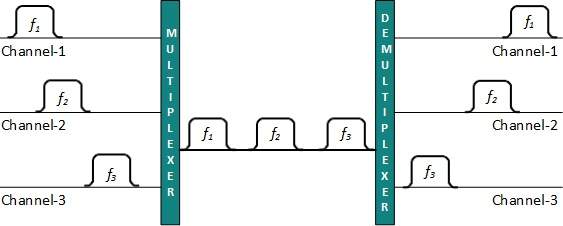
Time Division Multiplexing
TDM is applied primarily on digital signals but can be applied on
analog signals as well. In TDM the shared channel is divided among its
user by means of time slot. Each user can transmit data within the
provided time slot only. Digital signals are divided in frames,
equivalent to time slot i.e. frame of an optimal size which can be
transmitted in given time slot.
TDM works in synchronized mode. Both ends, i.e. Multiplexer and
De-multiplexer are timely synchronized and both switch to next channel
simultaneously.
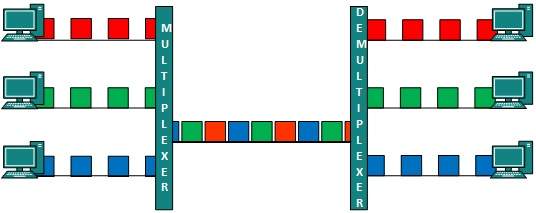
When channel A transmits its frame at one end,the De-multiplexer
provides media to channel A on the other end.As soon as the channel A’s
time slot expires, this side switches to channel B. On the other end,
the De-multiplexer works in a synchronized manner and provides media to
channel B. Signals from different channels travel the path in
interleaved manner.
Wavelength Division Multiplexing
Light has different wavelength (colors). In fiber optic mode,
multiple optical carrier signals are multiplexed into an optical fiber
by using different wavelengths. This is an analog multiplexing
technique and is done conceptually in the same manner as FDM but uses
light as signals.
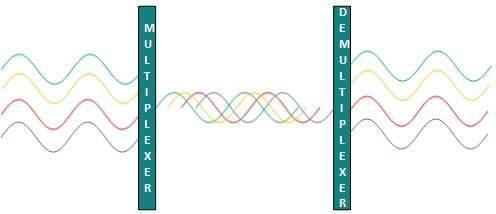
Further, on each wavelength time division multiplexing can be incorporated to accommodate more data signals.
Code Division Multiplexing
Multiple data signals can be transmitted over a single frequency by
using Code Division Multiplexing. FDM divides the frequency in smaller
channels but CDM allows its users to full bandwidth and transmit signals
all the time using a unique code. CDM uses orthogonal codes to spread
signals.
Each station is assigned with a unique code, called chip. Signals
travel with these codes independently, inside the whole bandwidth.The
receiver knows in advance the chip code signal it has to receive.
Network Switching
Switching is process to forward packets coming in from one port to a
port leading towards the destination. When data comes on a port it is
called ingress, and when data leaves a port or goes out it is called
egress. A communication system may include number of switches and
nodes. At broad level, switching can be divided into two major
categories:
Connectionless: The data is forwarded on behalf of forwarding tables. No previous handshaking is required and acknowledgements are optional.
Connection Oriented: Before switching data to be
forwarded to destination, there is a need to pre-establish circuit along
the path between both endpoints. Data is then forwarded on that
circuit. After the transfer is completed, circuits can be kept for
future use or can be turned down immediately.
Circuit Switching
When two nodes communicate with each other over a dedicated
communication path, it is called circuit switching.There 'is a need of
pre-specified route from which data will travels and no other data is
permitted.In circuit switching, to transfer the data, circuit must be
established so that the data transfer can take place.
Circuits can be permanent or temporary. Applications which use circuit switching may have to go through three phases:
Establish a circuit
Transfer the data
Disconnect the circuit
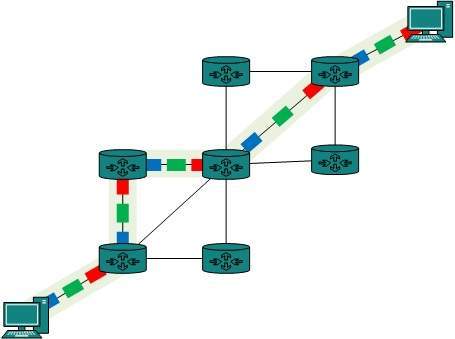
Circuit switching was designed for voice applications. Telephone is
the best suitable example of circuit switching. Before a user can make a
call, a virtual path between caller and callee is established over the
network.
Message Switching
This technique was somewhere in middle of circuit switching and
packet switching. In message switching, the whole message is treated as
a data unit and is switching / transferred in its entirety.
A switch working on message switching, first receives the whole
message and buffers it until there are resources available to transfer
it to the next hop. If the next hop is not having enough resource to
accommodate large size message, the message is stored and switch waits.
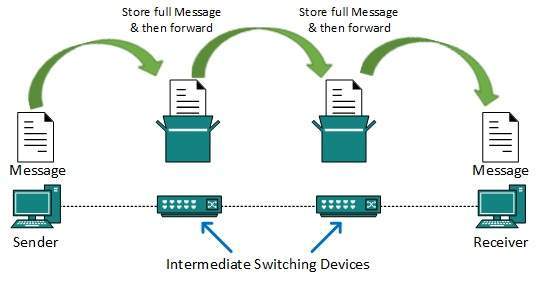
This technique was considered substitute to circuit switching. As in
circuit switching the whole path is blocked for two entities only.
Message switching is replaced by packet switching. Message switching
has the following drawbacks:
Every switch in transit path needs enough storage to accommodate entire message.
Because of store-and-forward technique and waits included until resources are available, message switching is very slow.
Message switching was not a solution for streaming media and real-time applications.
Packet Switching
Shortcomings of message switching gave birth to an idea of packet
switching. The entire message is broken down into smaller chunks called
packets. The switching information is added in the header of each
packet and transmitted independently.
It is easier for intermediate networking devices to store small size
packets and they do not take much resources either on carrier path or in
the internal memory of switches.
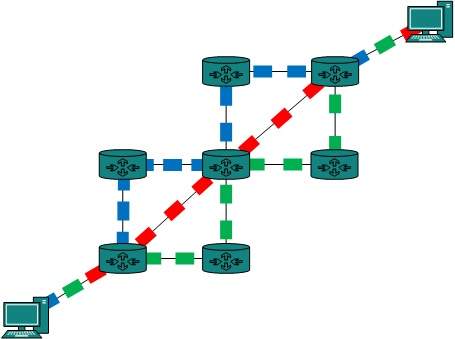
Packet switching enhances line efficiency as packets from multiple
applications can be multiplexed over the carrier. The internet uses
packet switching technique. Packet switching enables the user to
differentiate data streams based on priorities. Packets are stored and
forwarded according to their priority to provide quality of service.



































No comments:
Post a Comment